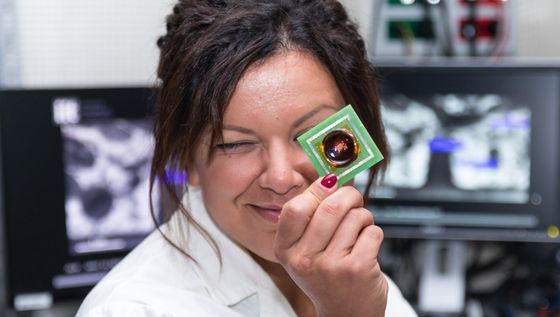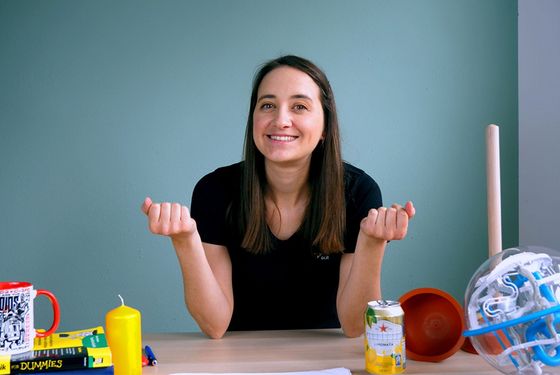|
||||||||
|
||||||||||||||||||||||||
|
|
among the more than 45,000 people who comprise the Helmholtz Association there are some unusual career paths. Sina Kürtz is a physicist and works at DLR in the promotion of young scientists. She also runs the successful YouTube channel “Sun, Death and Stars”, which primarily explains astrophysical phenomena such as gravitational waves and galaxy collisions to young girls and women. The channel is now part of Funk, the youth channel of ARD and ZDF. You can find out more about Sina Kürtz in this newsletter. Also: Retina-like biochips - researchers at Forschungszentrum Jülich have succeeded in developing an intelligent biochip that mimics the retina of the eye. And: Prevention is our most powerful weapon against cancer - a viewpoint from Michael Baumann, Chairman of the German Cancer Research Center. |
|
|
|
|||||||||||||||||||||||
|
|
|
|
||||||||||||||||||||||||||||||
|
|
|
The chip - created as a joint effort by scientists from Forschungszentrum Jülich, RWTH Aachen University, Istituto italiano di tecnologia and the University of Naples - is based on conductive polymers and light-sensitive molecules that can be used to imitate the retina, complete with visual pathways. “Our organic semiconductor recognizes how much light falls on it. Something similar happens in our eye. The amount of light that hits the individual photoreceptors ultimately creates the image in the brain,” explains Santoro, What is exceptional about the new semiconductor: it consists entirely of non-toxic organic components, is flexible and works with ions, that is, with charged atoms or molecules. It can thus be integrated into biological systems much better than conventional semiconductor components made of silicon, which are rigid and only work with electrons. Our body cells specifically use ions to control certain processes and exchange information,” explains the researcher. However, the development is, so far, only a “proof-of-concept”, she emphasizes. The material was synthesized and then characterized: “We were able to show that the typical properties of the retina can be imitated with it,” she says. The researchers are already thinking about another possible application: the chip could also function as an artificial synapse as light irradiation changes the conductivity of the polymer that is used in the short and long term. Real synapses work in a similar way: by passing on electrical signals, they change their size and efficiency, for example, which is the basis for our brain’s learning and memory capacity. Santoro is looking ahead: “In future experiments, we want to couple the components with biological cells and connect many individual ones together.” (Image: Instituta Italiano di Techonologica) Published in Nature Communications
First images from Euclid Heart repair via neuroimmune crosstalk |
|
To generate enthusiasm! In DLR’s promotion of young scientists, we often work on projects where we experience the children’s feedback live, such as the DLR_Raumfahrt_Show. It’s always exciting to see whether our own enthusiasm for research and science also infects the target group. How can we arouse curiosity, how can we give them a “Wow” experience and spark that twinkle in their eyes? A group of schoolgirls took part in the Science Year 2023 projects, some of whom had already dropped physics as a school subject. Their interests really changed again afterwards, I was very pleased about that!
The biggest science festival in the world especially for schoolchildren! We rent a site the size of Frankfurt Airport and then there’s a week of workshops, talks, panels, experiment stations, games, music, science slams and everything to do with science, the future and research. Overnight accommodation is included and in the evening there’s either an Interstellar movie night followed by an astrophysics talk or a party and networking event with people from research and science. It’s best to do all this during the first week after the summer vacation. During this week, the pupils may even decide for themselves what the science curriculum should include in the coming school year.
Can it also be someone from history? I always wanted to meet Leonardo da Vinci. Someone like him, who was both an artist and a scientist, would certainly have great ideas for science communication in 2023! |
|
|
|
In the next twenty years, the number of cancer cases worldwide will increase significantly. In Germany, we currently have around 510,000 new cases of cancer every year, and more than 200,000 people die from cancer. By 2030, we expect to see around 600,000 new cases of cancer every year. Around 40 percent of all new cases of cancer in Germany are attributable to a few preventable cancer risk factors: Tobacco consumption, an unhealthy diet, obesity, lack of exercise, high alcohol consumption and certain infections. Consistent primary prevention can prevent a large proportion of these cases, while the causes of the remaining 60 percent of cancer cases are not yet fully understood. The healthcare system in Germany, as in most industrialized countries, is primarily geared towards the treatment of diseases, as expressed by the term “reparative medicine”, yet our most powerful weapons against cancer are prevention and early detection. Unfortunately, however, there is a glaring lack of long-term and targeted prevention research in Germany, and the implementation of our knowledge is also inadequate. There is a lack of coordinated, long-term information campaigns and accompanying evaluation research. There is a lack of programs that are targeted at different population groups and that reach people with a particularly high risk of cancer. We need suitable structures and the political will to make it easier for people to lead a healthy lifestyle and to motivate them to take advantage of early cancer detection.
There is a need for research to answer key prevention questions: How does cancer develop and at which molecular “adjusting screws” can this process be stopped? What motivates people to avoid known cancer risk factors? How can tumors be detected even earlier? What increases health literacy at an individual and system level? What potential does digitalization offer for cancer prevention? To make progress in these fields, advances in data analysis and data management are necessary. The National Cancer Prevention Center, which we are establishing in Heidelberg together with German Cancer Aid, will be an important hub and leader of cancer prevention research in Germany, but it cannot accomplish these tasks alone. In order to tackle this major challenge for a healthier future, we need further support from the life sciences and medicine, as well as the expertise of data scientists, educators, psychologists and other specialist disciplines. A consistently cancer-preventive lifestyle demands a lot from each individual. However, research findings and the resulting appeals to individual insight are only part of the solution. After all, the environment and social factors make it easier or more difficult for people to follow prevention recommendations. That is why we are equally committed to legislation that makes it easier for everyone to lead a health-conscious life through the use of incentives, taxation or advertising restrictions. Because even if the successes of cancer prevention only become visible in the statistics after decades, the same applies to every individual: If you decide to adopt a healthier lifestyle, you immediately reduce your lifetime risk of developing cancer! (Photo: Uwe Anspach) |
Published by: Helmholtz Association of German Research Centres, Anna-Louisa-Karsch-Str.2, 10178 Berlin Questions to the editors should be sent to monthly@helmholtz.de
No subscription yet? Click here to register If you no longer wish to receive our newsletter, simply click here: Unsubscribe © Helmholtz
|
![[Translate to Englisch:] [Translate to Englisch:]](https://www.helmholtz.de/assets/helmholtz_gemeinschaft/_processed_/7/8/csm_Martin_Trinkaus_Monthly_600x600_02_23e1fa7729.png)



![[Translate to Englisch:] [Translate to Englisch:] Prof. Dr. med. Dr. h.c. Michael Baumann, Vorstandvorsitzender und Wissenschaftlicher Vorstand des Deutschen Krebsforschungszentrums. Bild: Uwe Anspach](https://www.helmholtz.de/assets/helmholtz_gemeinschaft/_processed_/7/6/csm_Baumann_Michael_c_Uwe_Anspach_1920x_0e1113f3cd.jpg)